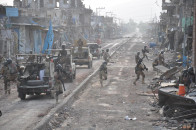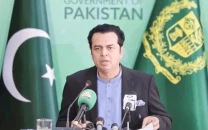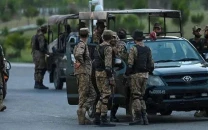Water woes– part IV: Faisalabad’s textile industry, boon or bane?
Contaminated drinking water is becoming a cause for widespread water-borne diseases.

Overcrowded wards and corridors of government and private hospitals with patients suffering from gastroenteritis and diarrhoea speak volumes of the government’s inability to provide safe drinking water. Come summer, and it only gets worse as the demand for water rises.
Faisalabad today is known as the ‘Manchester of Pakistan’ owing to the large network of textile units located in the city, but for its residents this industrial growth only means a rise in hospital bills because their only source of drinking water – River Chenab – is polluted with industrial waste.
A tiny town, founded mainly for catering to the food requirements of the district’s inhabitants, Faisalabad has now emerged as one of the leading metropolitan cities, which ranks as the country’s third most populous city and second in terms of industrial growth.
Its current population stands at 7.2 million and is growing at a pace of 2.51 per cent annually, meaning it will likely touch 89 million by 2020. Yet, the Water and Sanitation Agency (WASA) seems to lack the vision and resources to come up with a strategy to meet its water requirements.
Situated between Ravi River and Chenab River, Faisalabad forms a part of Rachna Doab. In the wake of contaminated water within the city, it is the Lower Chenab canal which has remained the main source of water for irrigation and helps cultivate almost 80 per cent of the lands. In the urban areas, water from the same riverbed is supplied via 40 kilometre-long pipelines, but it is contaminated.
To begin with, the city was never planned in terms of being an industrial zone, say experts.
It was initially the responsibility of WASA to lay out separate water lines for industrial and residential consumption, failing which is now resulting in choked sewerage lines and causing industrial pollution.
Furthermore, industries which were set up away from residential areas some four decades ago have today become a part of these areas owing to their expansion, as well as the increasing population.
Among the main industrial consumers of water are textile industries [printing, processing and dyeing], chemical factories, ice factories, soft drink factories and cold storage units – all of which dispose of their waste into Chenab River – and, ultimately, into households via public taps.
As a result, over 75 per cent of people are forced to drink contaminated, brackish water. “The water from our taps has a foul stench. We know it’s contaminated, but have to drink it because we cannot afford bottled-water,” said Mohammad Aslam, a resident of Railway Colony, one of the many slums in Faisalabad.
He complains that the water and sewerage lines laid by WASA are obsolete, but the government has taken no measures to repair them.
Alternative water supplies are no less of a nuisance. Those who rely on handpumps and electric motors also have to consume subsoil underground water. This groundwater supply comes from two different sources: the Chiniot tube-well field near the Chenab River and the Rakh Branch Canal seepage near the city.
However, the quality of this water continues to deteriorate as well because the water table is on a constant decline.
In come the water vendors
Understanding the gravity of this crisis, private water vendors have recently stepped in to make some extra money from one of the most precious commodities: sweet water under their land.
It is believed that over 250 individuals and private groups who reside along the Rakh Branch Canal have installed tube-wells and are involved in the business of selling 70 to 100 million gallons of water per day to at least 2 million people in the urban areas. They reap handsome profits, say observers.
The price of a 10-litre can varies between Rs20 and Rs30 depending on the distance from the canal of sweet water. In remote areas, this water is sold at prices higher than soft drinks with no one to monitor its safety standards.
Previously, this business was considered illegal and the administration was seen taking action against private vendors, but since the past one year the local government has provided them legal cover by registering them with the town council.
For its part, the government says it was necessary to do so because WASA has been unable to meet the water demands of Faisalabad’s population. “The current water demand in the city is 150 million gallons per day (MGD), whereas production from different sources stands at 65 MGD,” disclosed Syed Zahid Aziz, managing director at WASA. “We are only able to cater to a mere 1.5 million consumers through a total of 209,000 connections.”
In order to reduce this gap between supply and demand, WASA authorities recently contacted the Japan International Cooperation Agency (JICA) through the Punjab government and the federal government and sought their assistance.
Under this project, an additional quantity of 20 MGD of drinking water would be supplied to people by adding 25 more tube-wells along Jhang Branch Canal, about 20 kilometres from the city. The project is likely to be completed by March 31, 2012.
Rural areas completely ignored
While projects are underway to cater to the water needs of the urban population, it is the rural area, which makes up for approximately 60 per cent of Doab district, that is the worst-hit. Yet, the government continues to ignore their concerns.
Here too, groundwater is hazardous for human consumption and water-borne diseases are a common phenomenon, with diarrhoea, gastroenteritis and hepatitis A, B, C and D being largely prevalent.
In 2009, the federal government initiated a project, Clean Water for All, under which it promised to install filter plants in 289 union councils, but the project was put on hold by the Punjab government under the pretext of “checking for pilferage and misappropriation of funds”.
It was also learnt that part of the reason for the withdrawal was WASA’s reluctance to take responsibility or supervise the project, saying they lacked the required resources to meet the operation and maintenance cost.
“This shows the lack of commitment on part of the government,” said Muhammad
Rasheed, a leading public health engineer, warns: “If a proper conservation strategy is not adopted and we continue to overexploit our groundwater reserves, we will soon be close to the finishing point.”
Edited by Saarysh Zuberi and Aroosa Masroor
Design: Samad Siddiqui
Published in The Express Tribune, September 17th, 2011.



















COMMENTS
Comments are moderated and generally will be posted if they are on-topic and not abusive.
For more information, please see our Comments FAQ